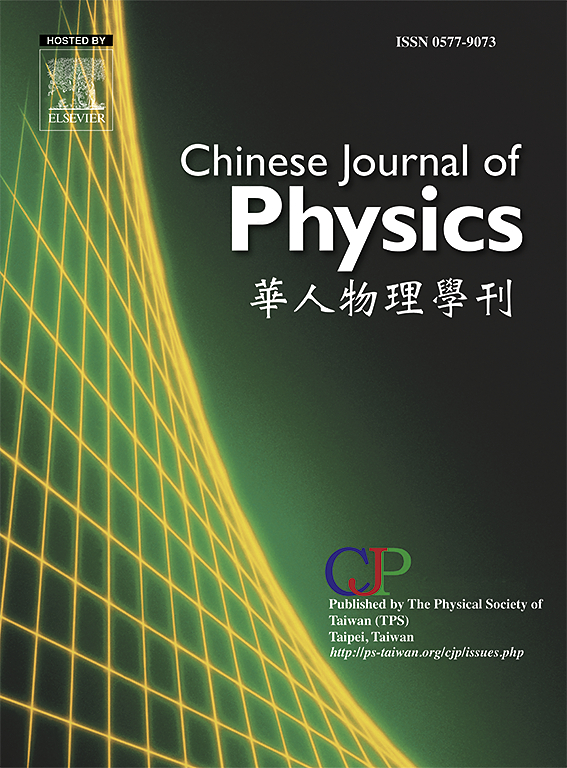熵校正Hořava-Lifshitz重力对修正查普金气体的影响:一个宇宙学参数估计
IF 4.6
2区 物理与天体物理
Q1 PHYSICS, MULTIDISCIPLINARY
引用次数: 0
摘要
近年来,寻找可行的替代标准ΛCDM模型的工作已经加强,特别是考虑到宇宙学观测中尚未解决的紧张局势以及对暗能量本质的持续需求。在这项研究中,我们分析了Hořava-Lifshitz重力的对数和幂律修正模型的宇宙学意义,并将修正的chaplygin气体作为暗能量候选者。使用联合卡方最小化技术,我们通过将这些模型拟合到BAO和Pantheon+数据集的观测数据中来进行参数估计。我们的分析为每个模型提供了关键宇宙学参数的最佳拟合值,包括哈勃常数(H0)、物质密度参数(Ωm0)和暗能量密度参数(ΩΛ0)。通过将我们的结果与ΛCDM进行比较,我们发现与观测数据非常吻合,表明这两种模型都可以作为标准宇宙学的可行替代方案。此外,我们还使用赤池信息准则(Akaike Information Criterion, AIC)和贝叶斯信息准则(Bayesian Information Criterion, BIC)等统计工具来评估模型的拟合优度和复杂度。在使用MCMC进行参数估计后,我们研究了关键宇宙学参数的行为,包括减速参数,状态方程(EoS)参数,jerak和snap参数。此外,我们还分析了各种宇宙学诊断,如状态检测器诊断、Om诊断和ω - ω '分析,以探索暗能量的演化及其与标准ΛCDM模型的偏差。最后,我们进行了线性扰动分析来研究物质波动的演化,进一步评估了我们的模型与宇宙学数据的稳定性和一致性。我们还绘制了fσ8(z)观测数据,以检验宇宙结构的增长速度,并将我们的模型与大尺度结构观测结果进行比较。这些发现表明,当熵修正Hořava-Lifshitz引力与统一的暗能量成分相结合时,为解决当前宇宙学中的挑战提供了一个有希望的框架。本文章由计算机程序翻译,如有差异,请以英文原文为准。
Impact of entropy-corrected Hořava-Lifshitz gravity on modified chaplygin gas: A cosmological parameter estimation
In recent years, the search for viable alternatives to the standard CDM model has intensified, particularly in light of unresolved tensions in cosmological observations and the ongoing need to better understand the nature of dark energy. In this study, we analyze the cosmological implications of the logarithmic and power-law corrected models of Hořava-Lifshitz gravity, taking modified chaplygin gas as the dark energy candidate. Using a joint chi-square minimization technique, we perform parameter estimation by fitting these models to observational data from BAO and datasets. Our analysis provides best-fit values for key cosmological parameters, including the Hubble constant (), matter density parameter (), and dark energy density parameter () for each model. By comparing our results with CDM, we find great agreement with observational data, demonstrating that both models can serve as viable alternatives to standard cosmology. Furthermore, we evaluated our models using statistical tools such as the Akaike Information Criterion (AIC) and Bayesian Information Criterion (BIC) to assess their goodness of fit and complexity. After performing parameter estimation using MCMC, we studied the behavior of key cosmological parameters, including the deceleration parameter, equation of state (EoS) parameter, jerk, and snap parameters. Additionally, we analyzed various cosmological diagnostics such as the statefinder diagnostic, Om diagnostic, and analysis to explore the evolution of dark energy and its deviation from the standard CDM model. Finally, we performed a linear perturbation analysis to study the evolution of matter fluctuations, further assessing the stability and consistency of our models with cosmological data. We also plotted observational data to examine the growth rate of cosmic structures and to compare our models with large-scale structure observations. These findings suggest that entropy-corrected Hořava-Lifshitz gravity, when combined with a unified dark energy component, offer a promising framework for addressing current challenges in cosmology.
求助全文
通过发布文献求助,成功后即可免费获取论文全文。
去求助
来源期刊

Chinese Journal of Physics
物理-物理:综合
CiteScore
8.50
自引率
10.00%
发文量
361
审稿时长
44 days
期刊介绍:
The Chinese Journal of Physics publishes important advances in various branches in physics, including statistical and biophysical physics, condensed matter physics, atomic/molecular physics, optics, particle physics and nuclear physics.
The editors welcome manuscripts on:
-General Physics: Statistical and Quantum Mechanics, etc.-
Gravitation and Astrophysics-
Elementary Particles and Fields-
Nuclear Physics-
Atomic, Molecular, and Optical Physics-
Quantum Information and Quantum Computation-
Fluid Dynamics, Nonlinear Dynamics, Chaos, and Complex Networks-
Plasma and Beam Physics-
Condensed Matter: Structure, etc.-
Condensed Matter: Electronic Properties, etc.-
Polymer, Soft Matter, Biological, and Interdisciplinary Physics.
CJP publishes regular research papers, feature articles and review papers.
 求助内容:
求助内容: 应助结果提醒方式:
应助结果提醒方式:


